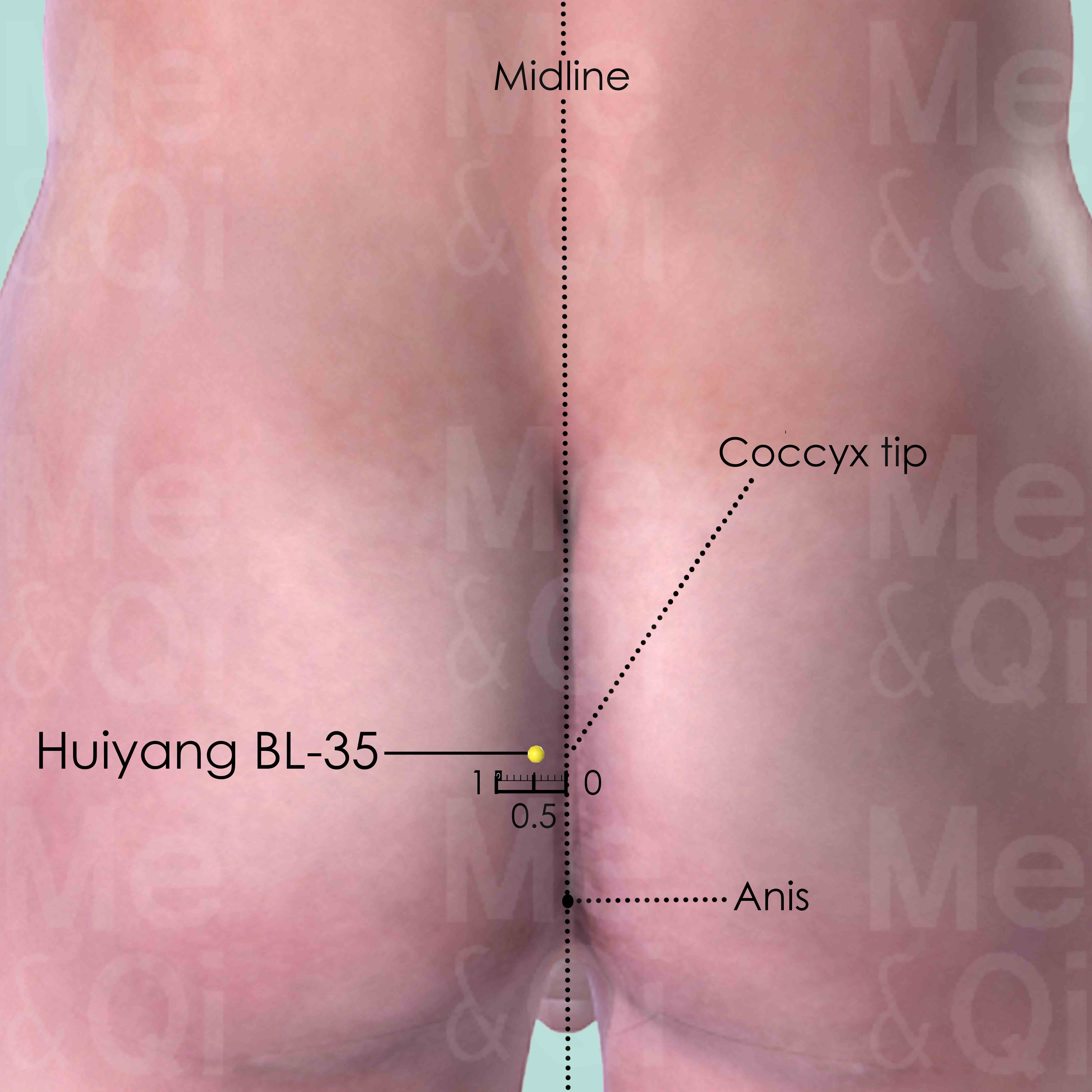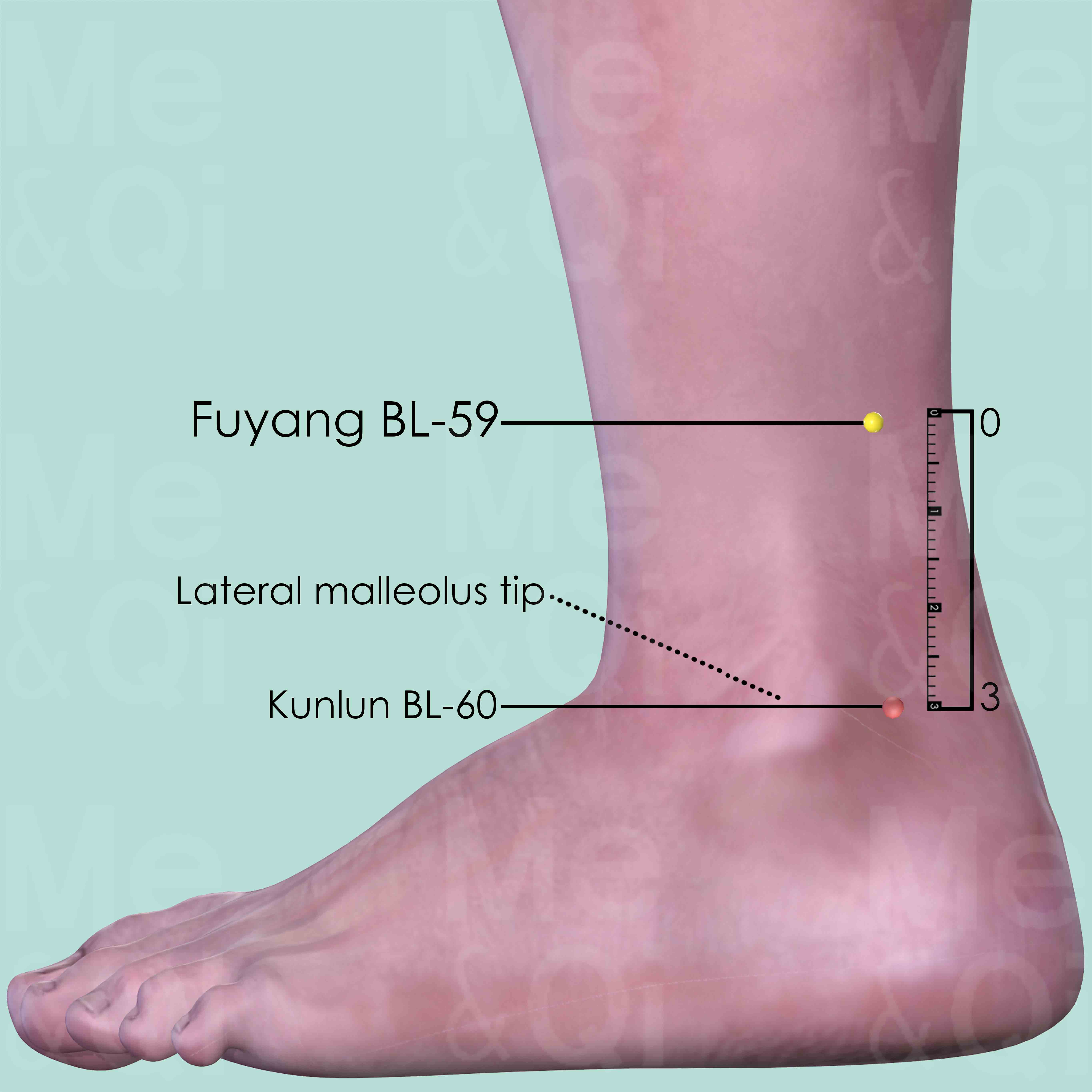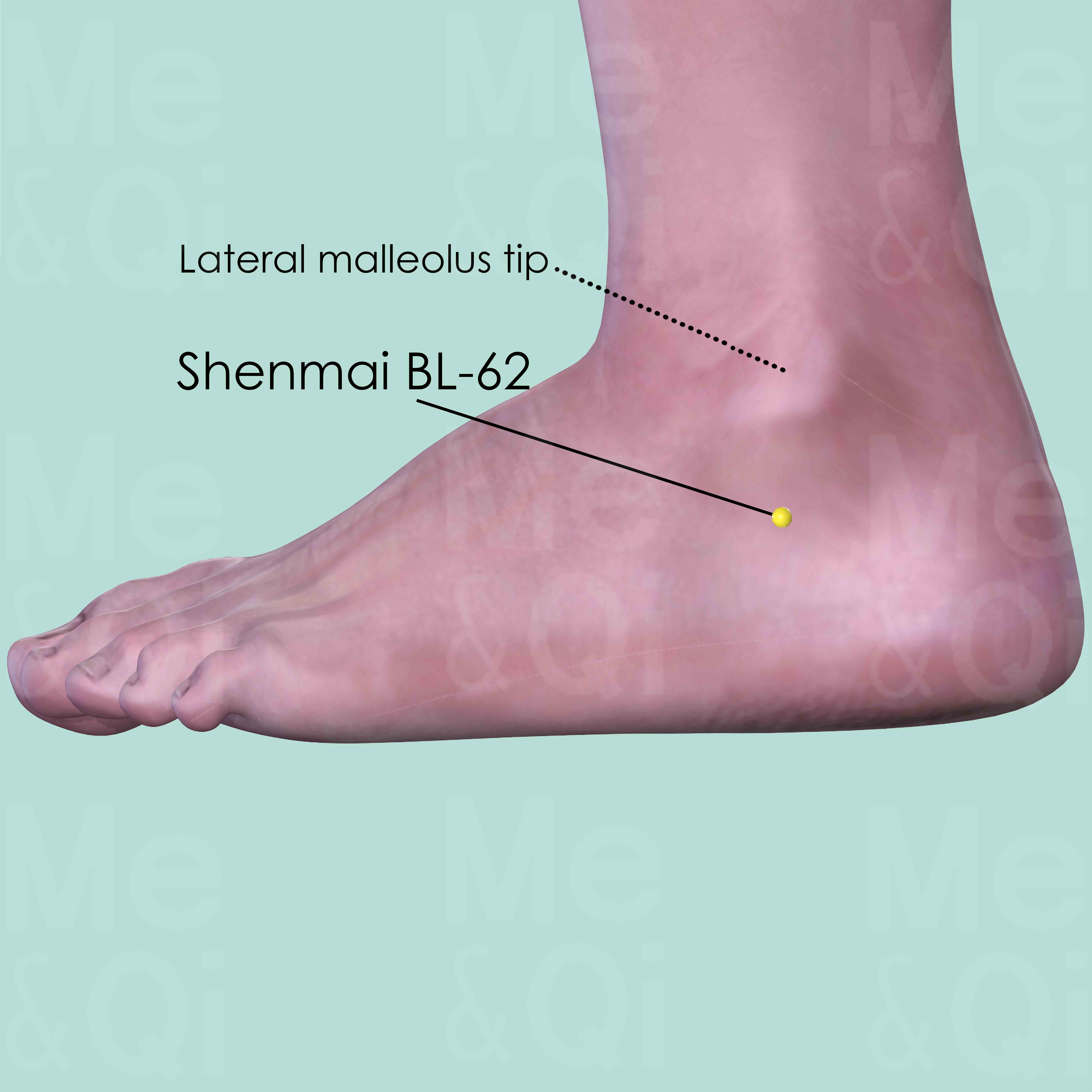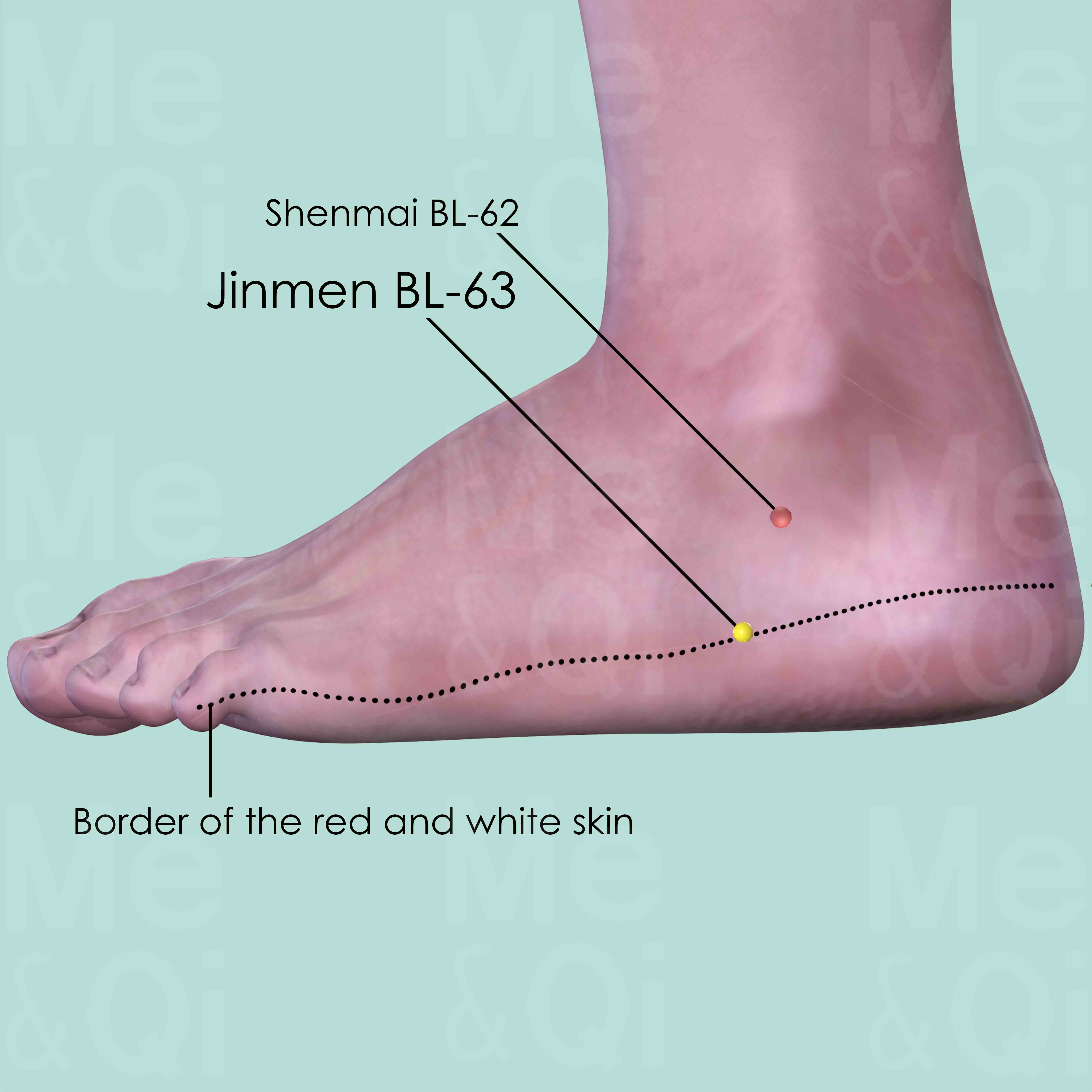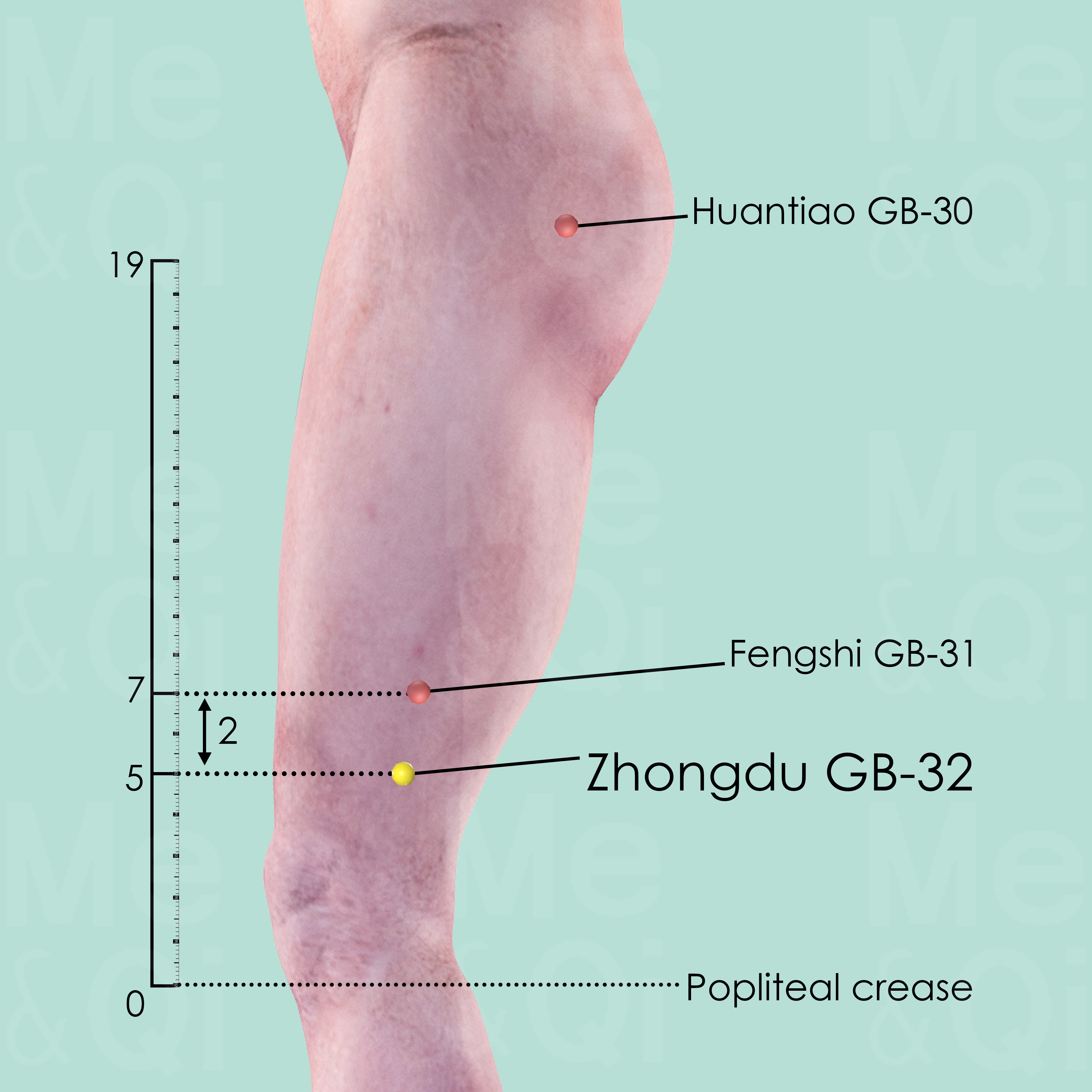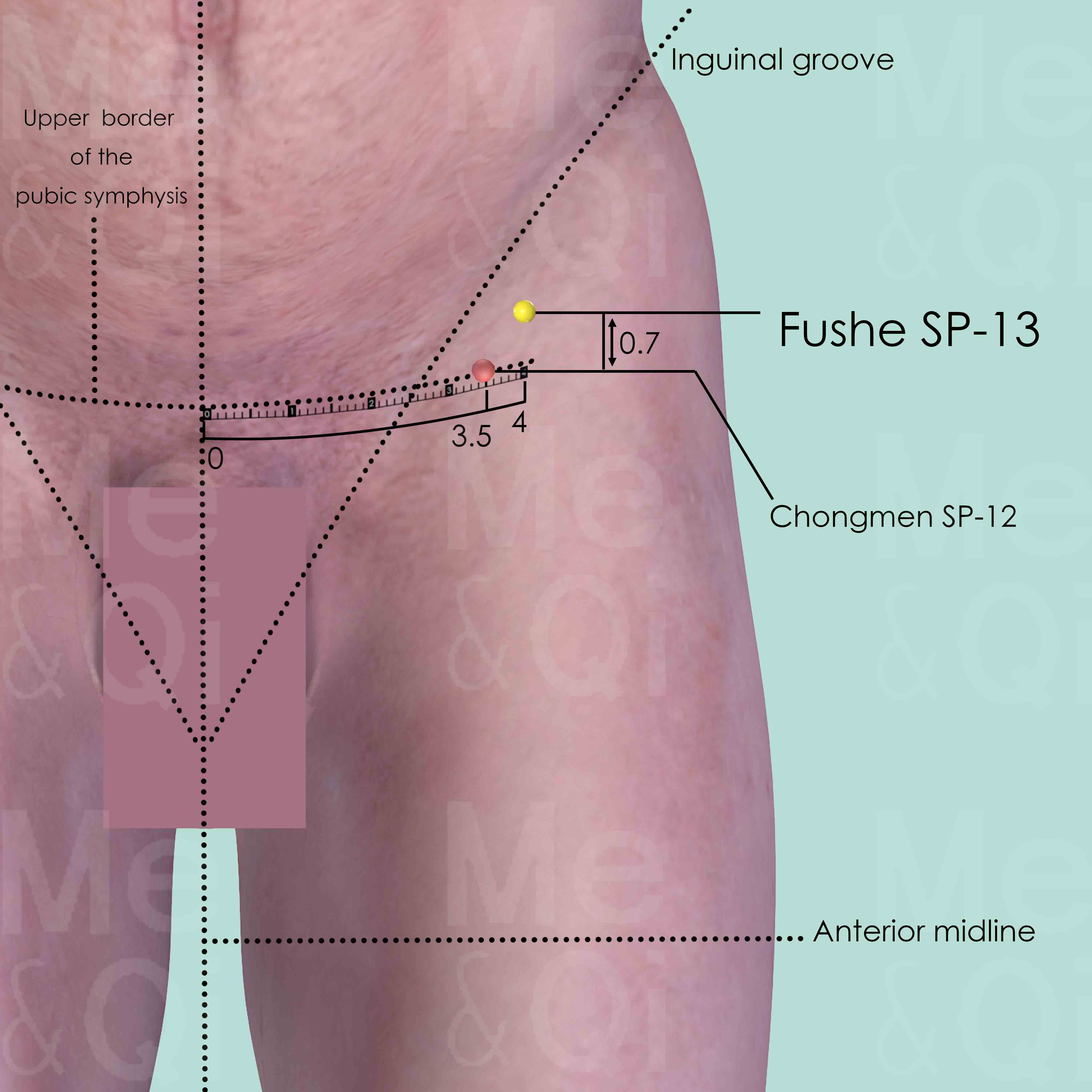Leg Painaccording to TCM
Symptom family: Legs disorders and Symptoms
Sub-symptom(s): Inner Leg Pain Thigh Pain Pain In The Outer Leg Inner Thigh Pain
What is Leg Pain?
Leg pain encompasses a range of discomforts in the lower limbs, from dull aches to sharp, acute pain. This symptom, often described as aching legs, soreness, or painful sensations in the legs, can manifest in various forms such as inner leg pain, thigh pain, pain in the outer leg, or inner thigh pain. It can result from various causes like muscular strain, nerve issues, or circulatory problems.
How Does TCM View Leg Pain?
Traditional Chinese Medicine (TCM) approaches leg pain as a manifestation of imbalances within the body's energy system. Unlike Western medicine, which often focuses on localized causes, TCM considers leg pain a symptom of broader disharmonies in Qi (vital energy), Blood, and Body Fluids.
TCM practitioners aim to identify and rectify the underlying pattern of disharmony, recognizing that leg pain can be a signal of systemic issues rather than just a localized problem.
Root Causes of Leg Pain in TCM
TCM identifies various patterns that can lead to leg pain. One common cause is the Stagnation of Qi and Blood, where the smooth flow of energy and nutrients through the body is impeded, leading to pain and discomfort in the legs.
Another typical pattern is the invasion of Cold or Dampness into the body's channels, especially in the legs, which can manifest as pain, heaviness, and aching. Addressing these imbalances through TCM methods is crucial for alleviating leg pain effectively. For women, the pattern of Coldin Uterus is often the cause of leg pain.
Explore below more details about what might cause Leg pain according to TCM.
- By Syndrome
- By Organ
- Cold
- Uterus
Cold
In TCM "Cold" as a pattern of disharmony refers to a specific type of imbalance within the body's systems, often linked to a deficiency or weakness. It's not about feeling physically cold or having a common cold, but rather a metaphorical description of certain symptoms and underlying conditions. When a TCM practitioner says someone suffers from "Cold," it usually implies that the body's Yang energy, which is warm and active, is insufficient or overpowered by Yin energy, which is cool and passive. Symptoms of Cold in TCM can include a general feeling of coldness, cold limbs, pale complexion, low energy, slow metabolism, and a preference for warmth. ... see more
Cold Patterns That Can Lead to Leg Pain
| Pattern Name | Relevant Symptoms | Relevant Formulas |
|---|---|---|
| Cold in the Uterus | Sore legs, Diarrhea, Lack of appetite, Generalized fatigue, General weakness, Thin vaginal discharge... see more | Wen Jing Tang | Shao Fu Zhu Yu Tang | Wen Qi Hua Shi Tang |
Uterus
In TCM the Uterus (or "Bao Gong") is not just a reproductive organ but a vital system closely linked to Kidney energy, responsible for menstrual health, fertility, and pregnancy. It's also connected to the Heart and Liver, reflecting the importance of emotional and blood health in reproductive wellness. In TCM, the Uterus is seen as a reservoir of Blood and Qi, crucial for reproductive health and general vitality. When the Uterus malfunctions or is imbalanced, it can lead to menstrual irregularities, infertility, miscarriages, or menopausal symptoms. Additionally, there might be symptoms like lower abdominal pain or emotional disturbances such as mood swings, often linked to Liver Qi stagnation. These manifestations highlight the TCM perspective that the health of the Uterus is intertwined with the overall balance of energy and blood in the body, as well as emotional well-being.... see more
Uterus Patterns That Can Lead to Leg Pain
| Pattern Name | Relevant Symptoms | Relevant Formulas |
|---|---|---|
| Cold in the Uterus | Sore legs, Diarrhea, Lack of appetite, Generalized fatigue, General weakness, Thin vaginal discharge... see more | Wen Jing Tang | Shao Fu Zhu Yu Tang | Wen Qi Hua Shi Tang |
TCM Herbal Formulas for Leg Pain
In TCM, treating leg pain involves using specific formulas and herbs tailored to the underlying pattern of imbalance. For Cold-related patterns, formulas like Wen Jing Tang, which contains Cinnamon twigs (Gui Zhi), a Warm/Acrid herb, are used to invigorate Blood and dispel Blood Stagnation, thereby alleviating pain. The choice of herbs and formulas depends on the individual's specific symptoms and constitution, ensuring a personalized approach to treatment.
Explore below some TCM herbal formulas used to address leg pain, organized by cause and by formula type.
- By Cause
- By Formula Type
- Cold
- Formulas that invigorate blood and dispel blood stagnation
- Formulas that warm the middle and dispel cold
Top Formula for Cold:
Wen Jing Tang
Suitable for Cold patterns that may cause leg pain, such as Cold in the Uterus
Learn moreAll Formulas Recommended for Leg Pain Caused by Cold
| Formula | Patterns Suitable For |
|---|---|
| Wen Jing Tang | Cold in the Uterus |
| Shao Fu Zhu Yu Tang | Cold in the Uterus |
| Wen Qi Hua Shi Tang | Cold in the Uterus |
Formulas that invigorate Blood and dispel Blood Stagnation
These formulas are suitable for some leg pain-causing patterns like Cold in the Uterus.
One such formula is Wen Jing Tang, with cinnamon twigs as a key herb.
Other formulas of this category are listed in the table below.
All "formulas that invigorate blood and dispel blood stagnation" recommended for leg pain
| Formula | Patterns Suitable For (if applicable) |
|---|---|
| Wen Jing Tang | Cold in the Uterus |
| Shao Fu Zhu Yu Tang | Cold in the Uterus |
Formulas that warm the middle and dispel Cold
These formulas are suitable for some leg pain-causing patterns like Cold in the Uterus.
One such formula is Wen Qi Hua Shi Tang, with atractylodes rhizome as a key herb.
Acupoints for Leg Pain
TCM also utilizes acupuncture as a remedy for leg pain, with specific acupoints being targeted to address the pain based on its underlying cause. Points on the Bladder Channel like Baihuanshu BL-30 and Chengjin BL-56 are used for their actions on the lower back and legs, helping to ease pain and strengthen these areas. In the Stomach Channel, points like Biguan ST-31 and Zusanli ST-36 are selected for their abilities to remove obstructions from the channel and expel Wind and Dampness.
The Gall Bladder Channel acupoints like Guangming GB-37 and Juliao GB-29 are chosen for their effectiveness in removing channel obstructions. Lastly, points on the Liver and Spleen Channels, such as Yinlian LIV-11 and Yinlingquan SP-9, are utilized for their regulatory effects on menstruation, tendons, the Spleen, and Dampness. Each acupoint is selected based on its specific actions and relevance to the individual's pattern of disharmony.
Explore below some acupoints used to address leg pain, organized by meridian.
- By Meridian
- Bladder Channel
- Stomach Channel
- Gall Bladder Channel
- Liver Channel
- Spleen Channel
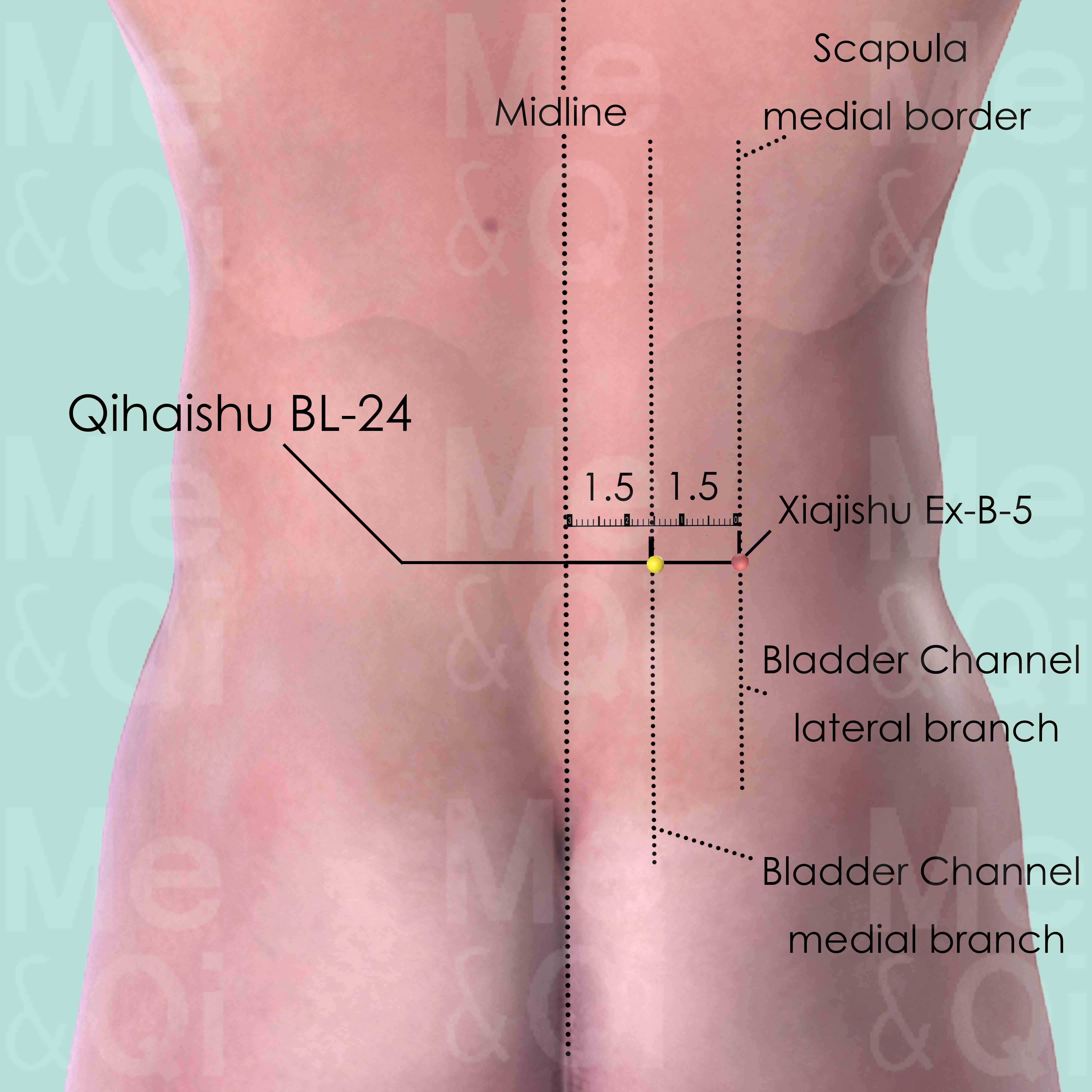
Qihaishu BL-24
1.5 cun lateral to the lower border of the spinous process of the 3rd lumber vertebra (L3).
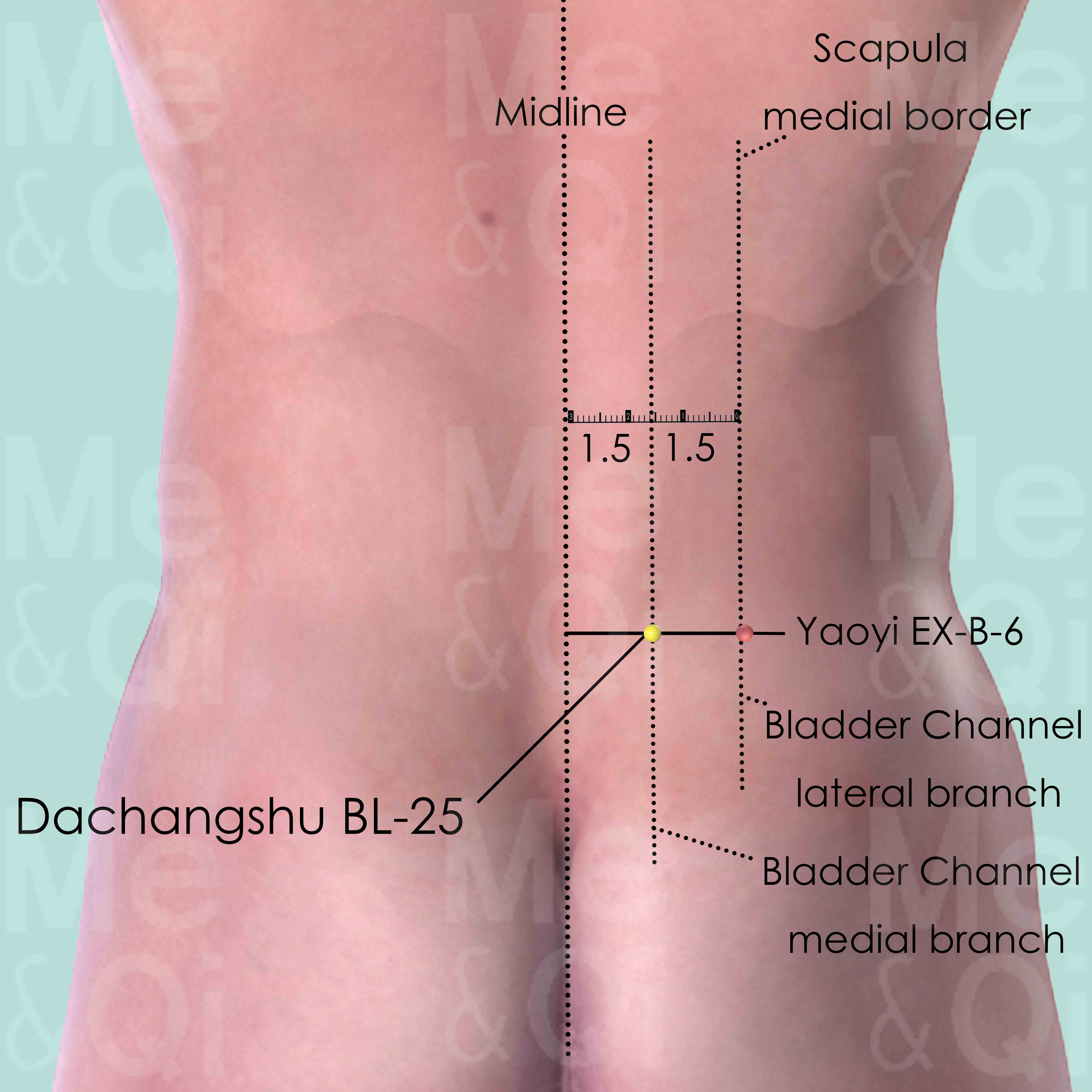
Dachangshu BL-25
1.5 cun lateral to the lower border of the spinous process of the 4th lumber vertebra (L4).
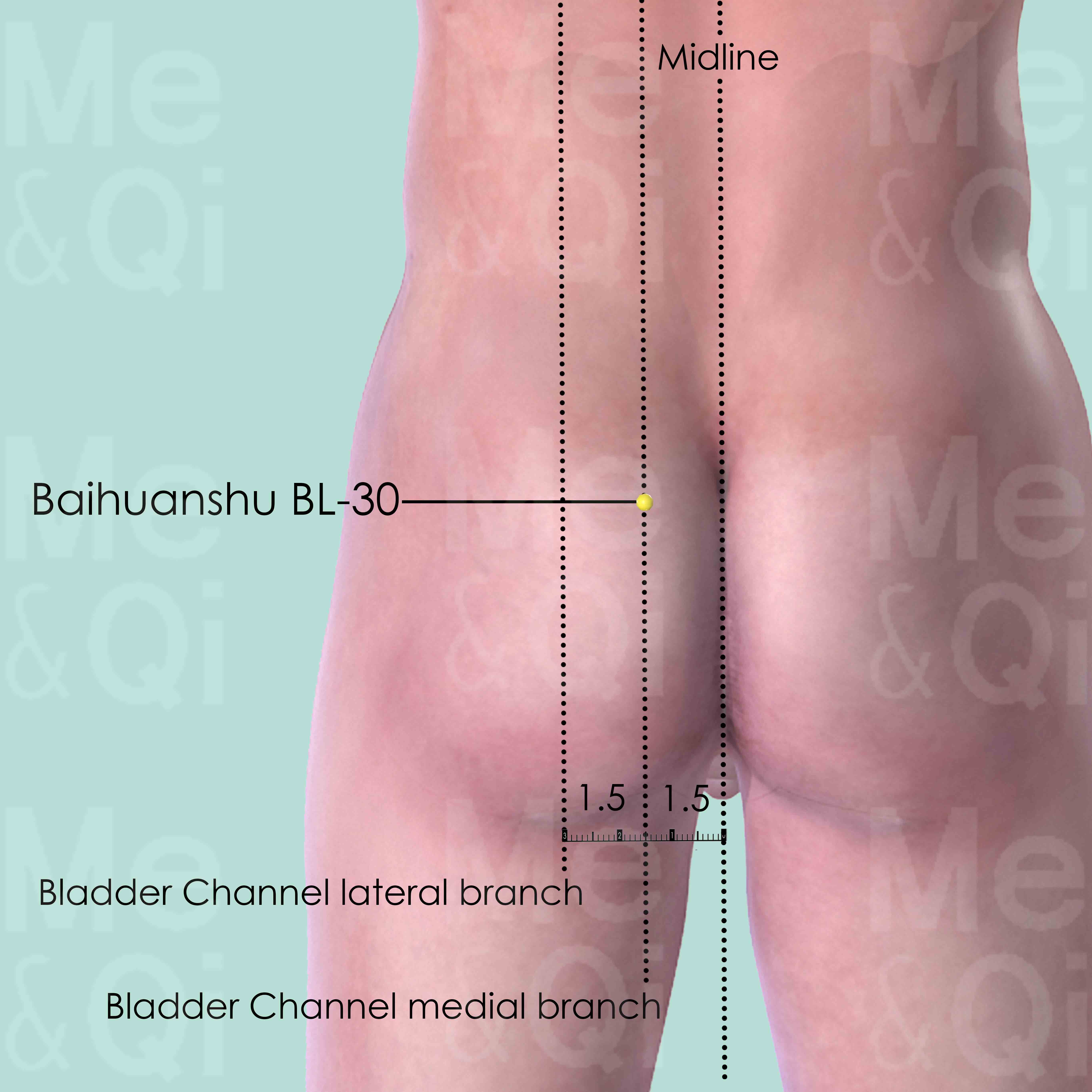
Baihuanshu BL-30
At the level of the 4th posterior sacral foramen, 1.5 cun lateral to the posterior midline.
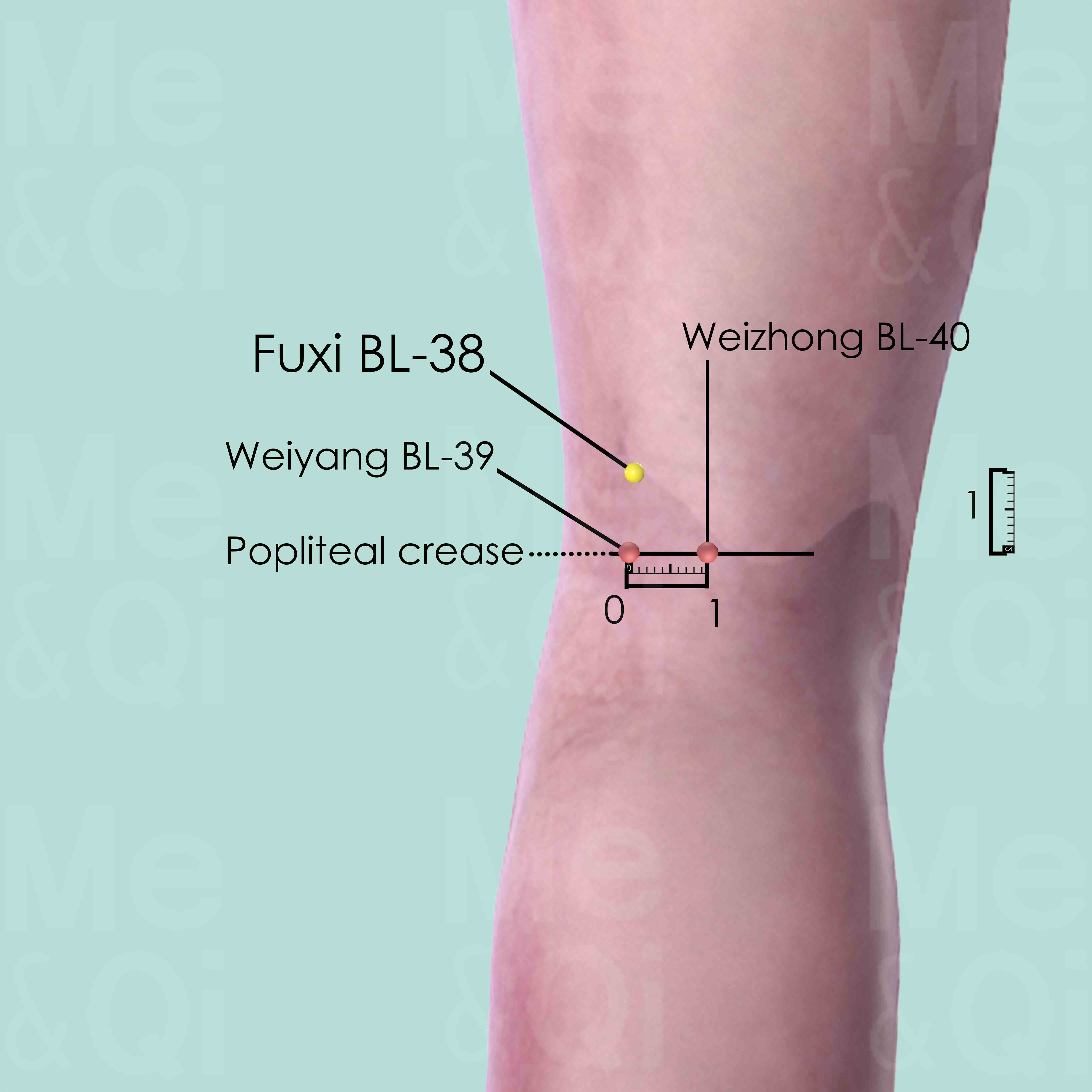
Fuxi BL-38
On the laterodorsal aspect of the knee, 1 cun superior and 1 cun lateral to Weizhong BL-40 which is in the center of the popliteal crease. It is also 1 cun above Weiyang BL-39, on the medial side of the tendon biceps femoris muscle.
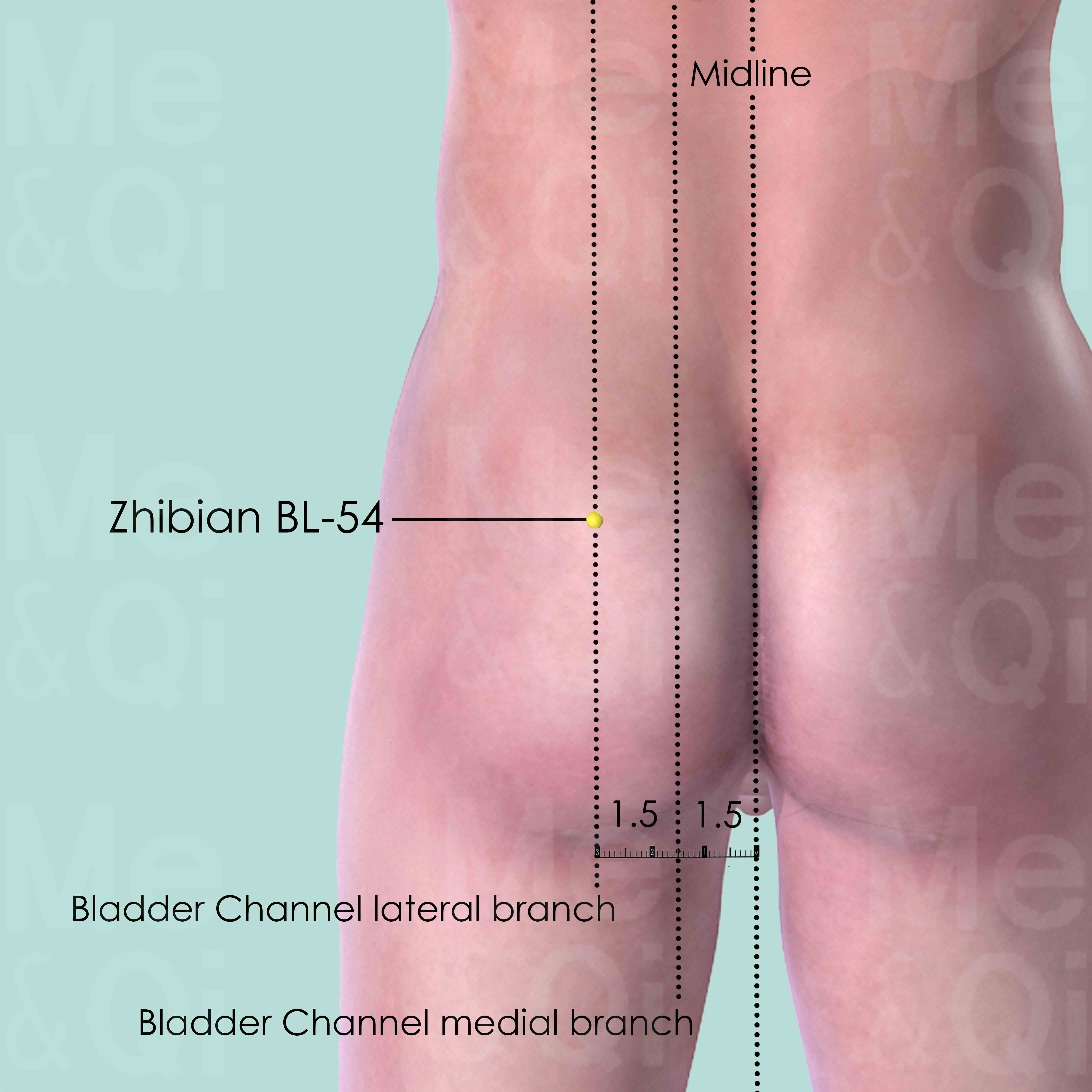
Zhibian BL-54
At the level of the 4th posterior sacral foramen, 3 cun lateral to the posterior midline.
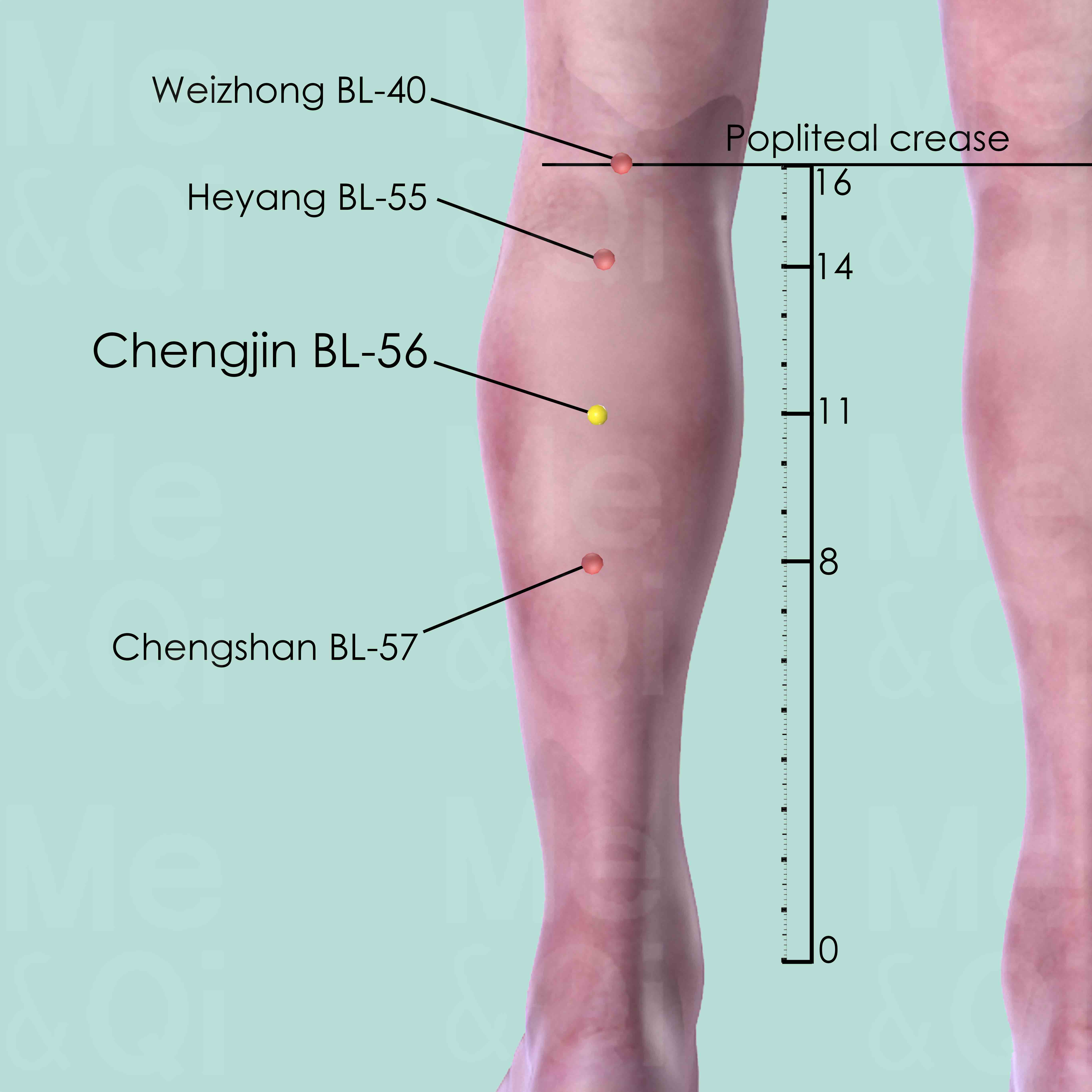
Chengjin BL-56
5 cun inferior to Weizhong BL-40 which is the midpoint of the popliteal crease. In the center of the belly of gastrocnemius muscle, midway between Heyang BL-55 and Chengshan BL-57.
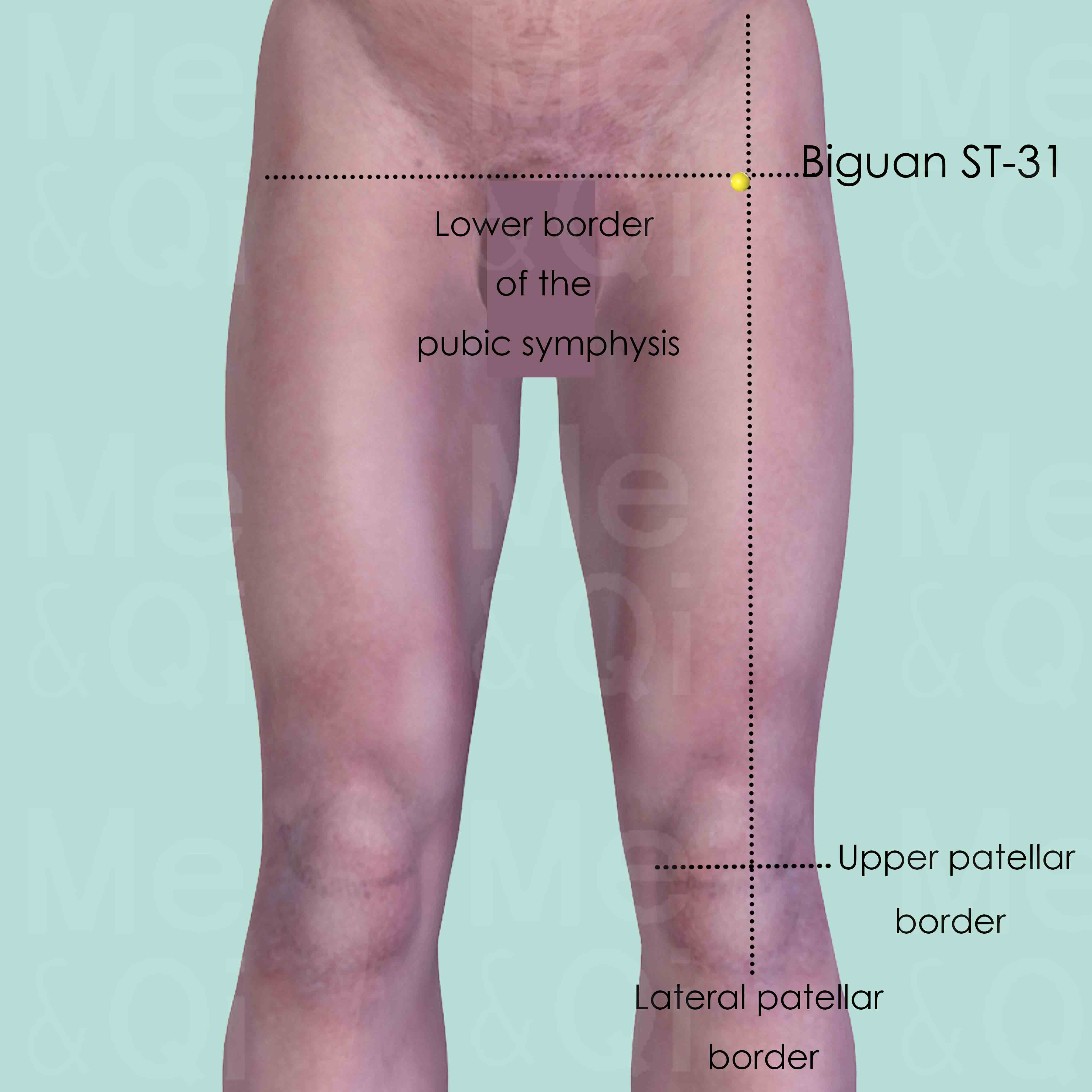
Biguan ST-31
Directly below the anterior superior iliac spine (ASIS), at the level of the lower border of the pubic symphysis, in the depression on the lateral side of sartorius muscle when the thigh is flex.
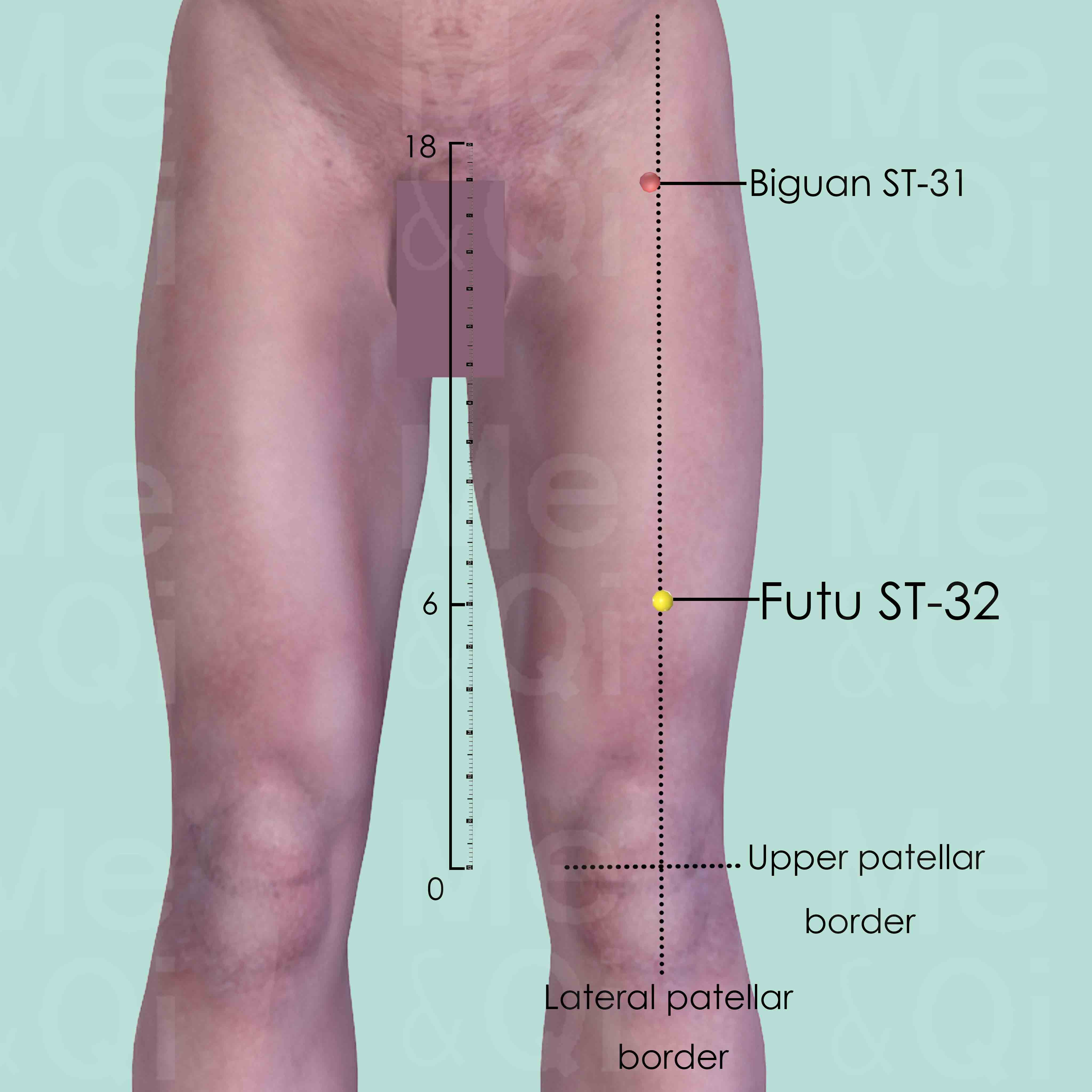
Futu ST-32
6 cun superior to the upper-lateral border of the patella, on the line connecting the anterior superior iliac spine (ASIS) and upper lateral border of the patella.
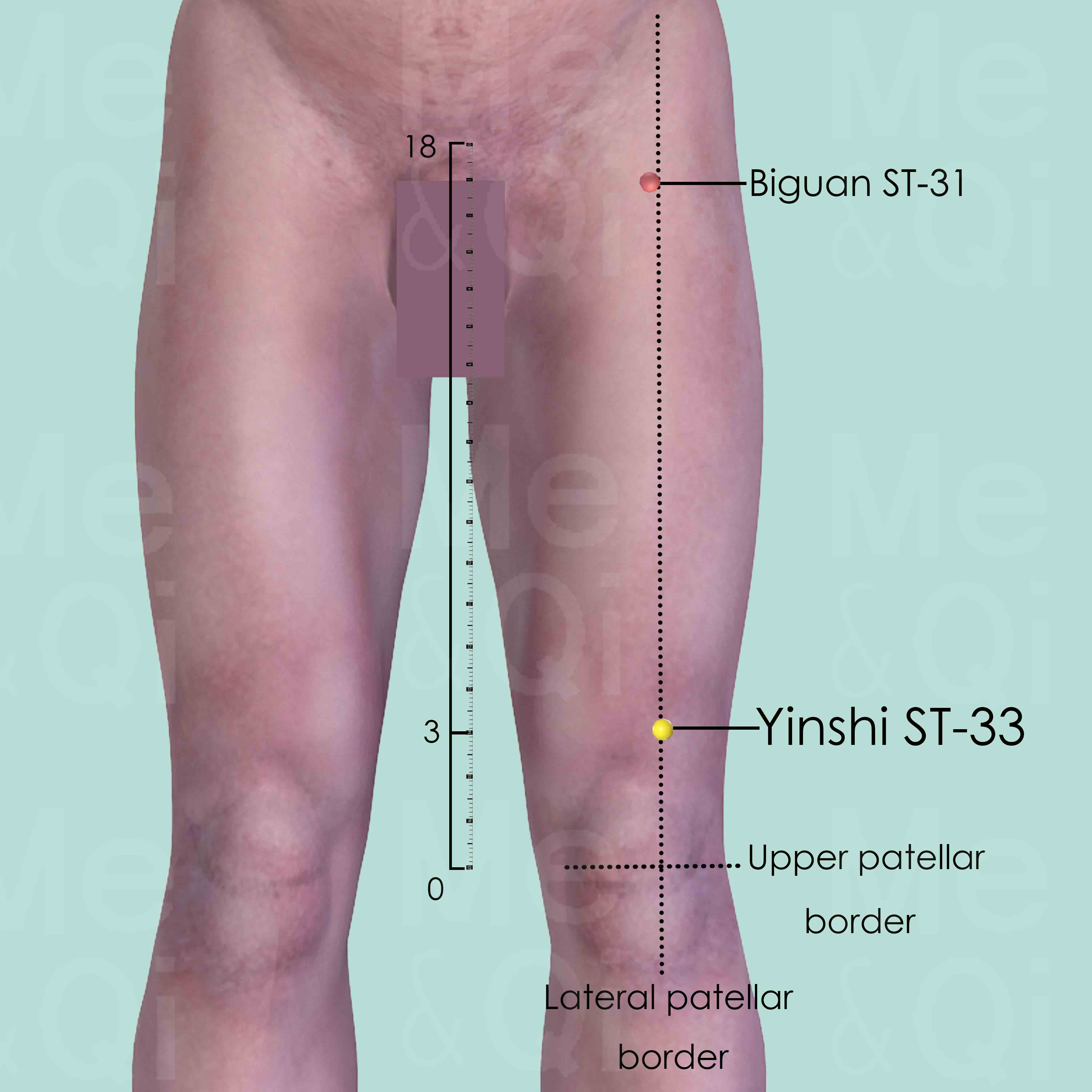
Yinshi ST-33
3 cun above the upper-lateral border of the patella, on a line between the lateral patellar border and the anterior superior iliac spine (ASIS).
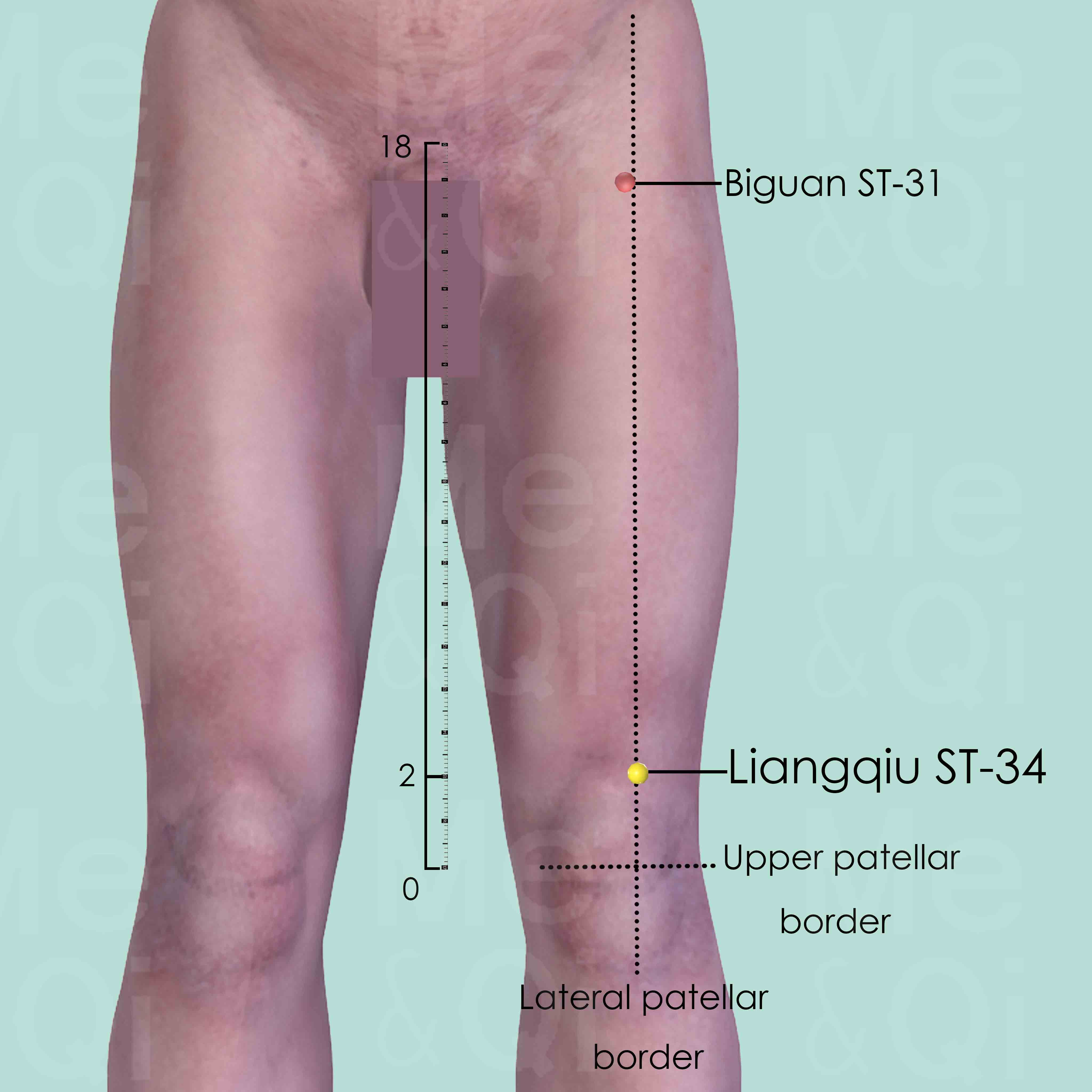
Liangqiu ST-34
2 cun above the upper-lateral border of the patella, on a line between the upper lateral patellar border and the anterior superior iliac spine (ASIS).
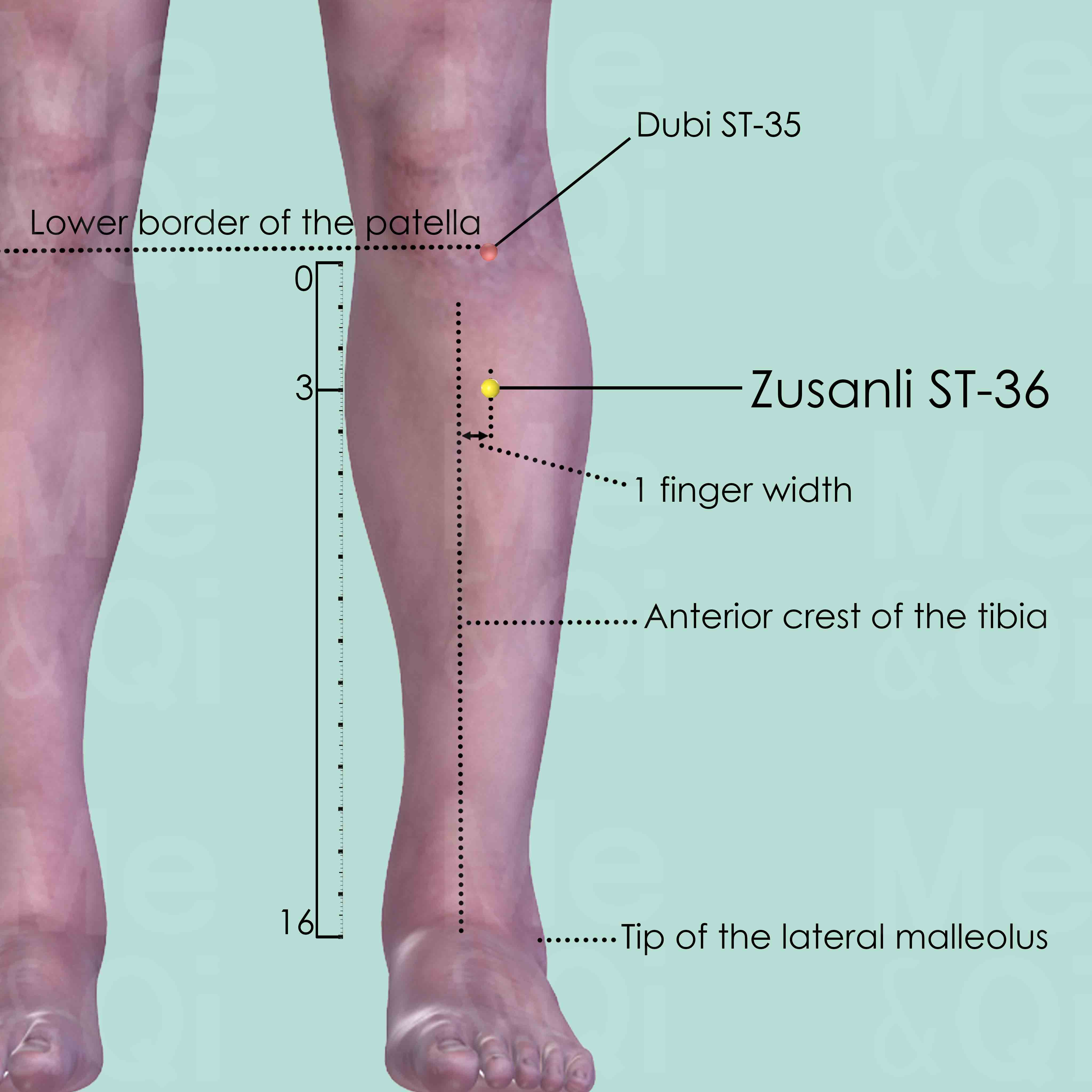
Zusanli ST-36
3 cun below Dubi ST-35, one finger breadth lateral to the anterior crest of the tibia, on the tibialis anterior muscle.
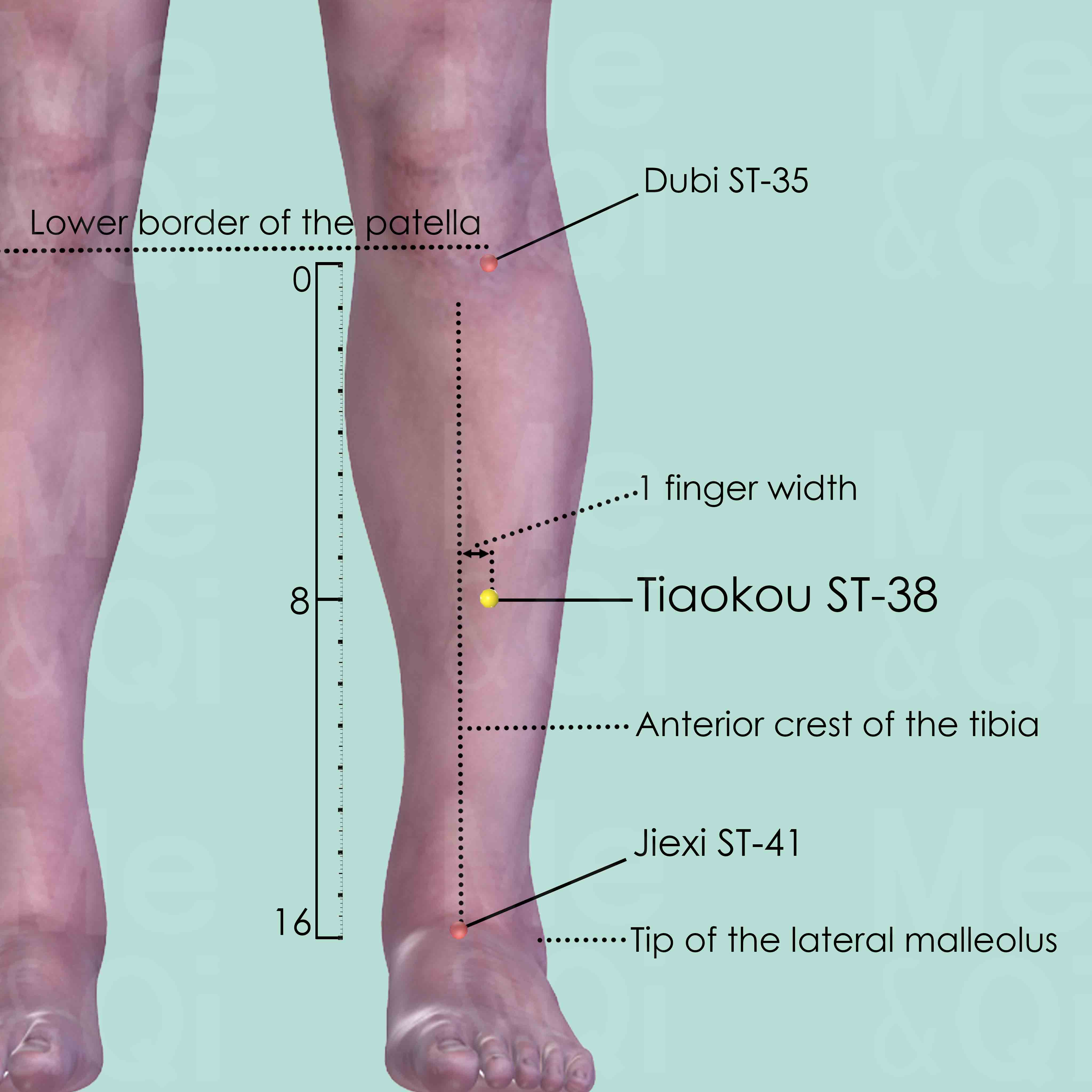
Tiaokou ST-38
8 cun below Dubi ST-35, midway between Dubi ST-35 and Jiexi ST-41, one middle finger-width from the anterior crest of the tibia.
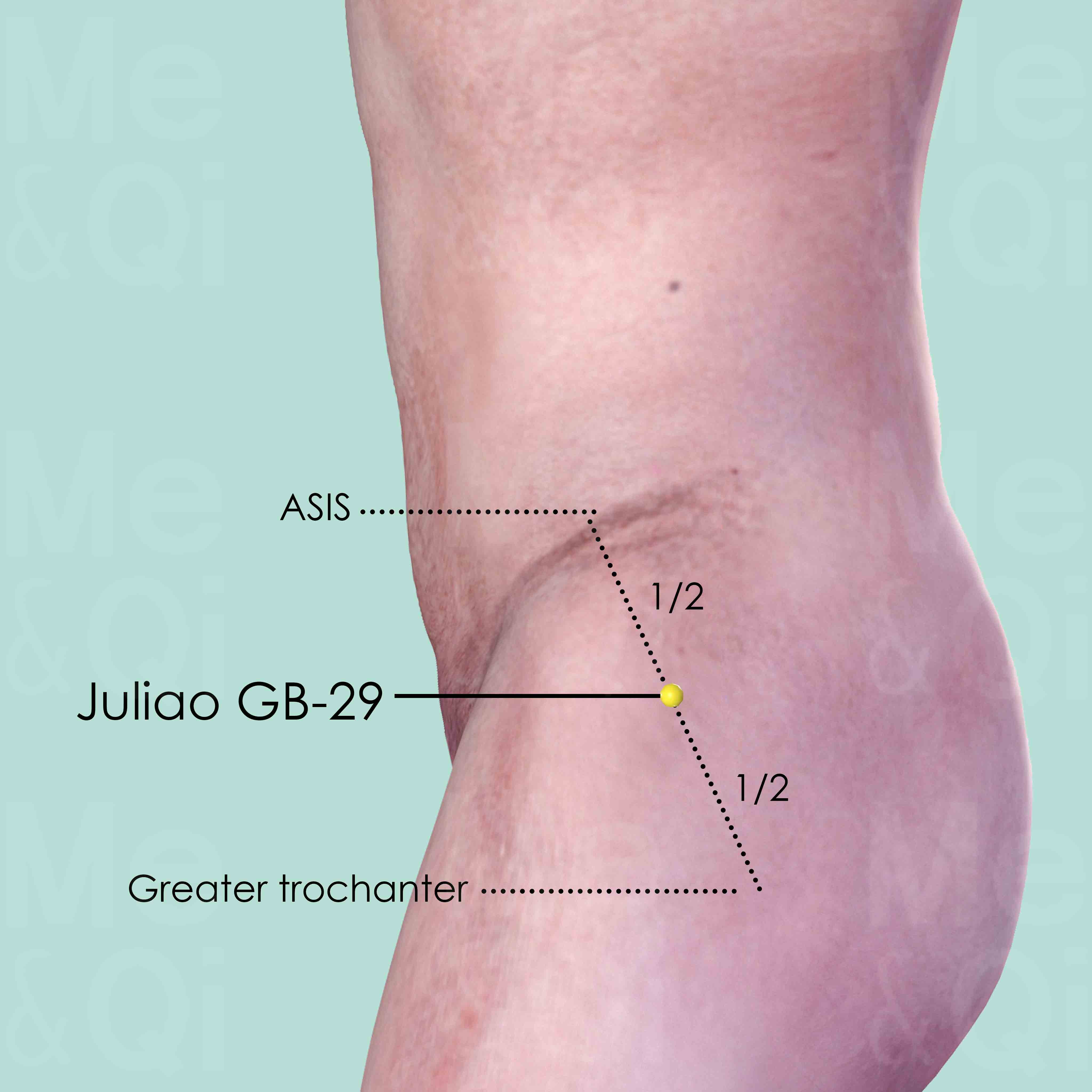
Juliao GB-29
Midway between the ASIS (anterior superior iliac spine) and the great trochanter, in the lateral recumbent position.
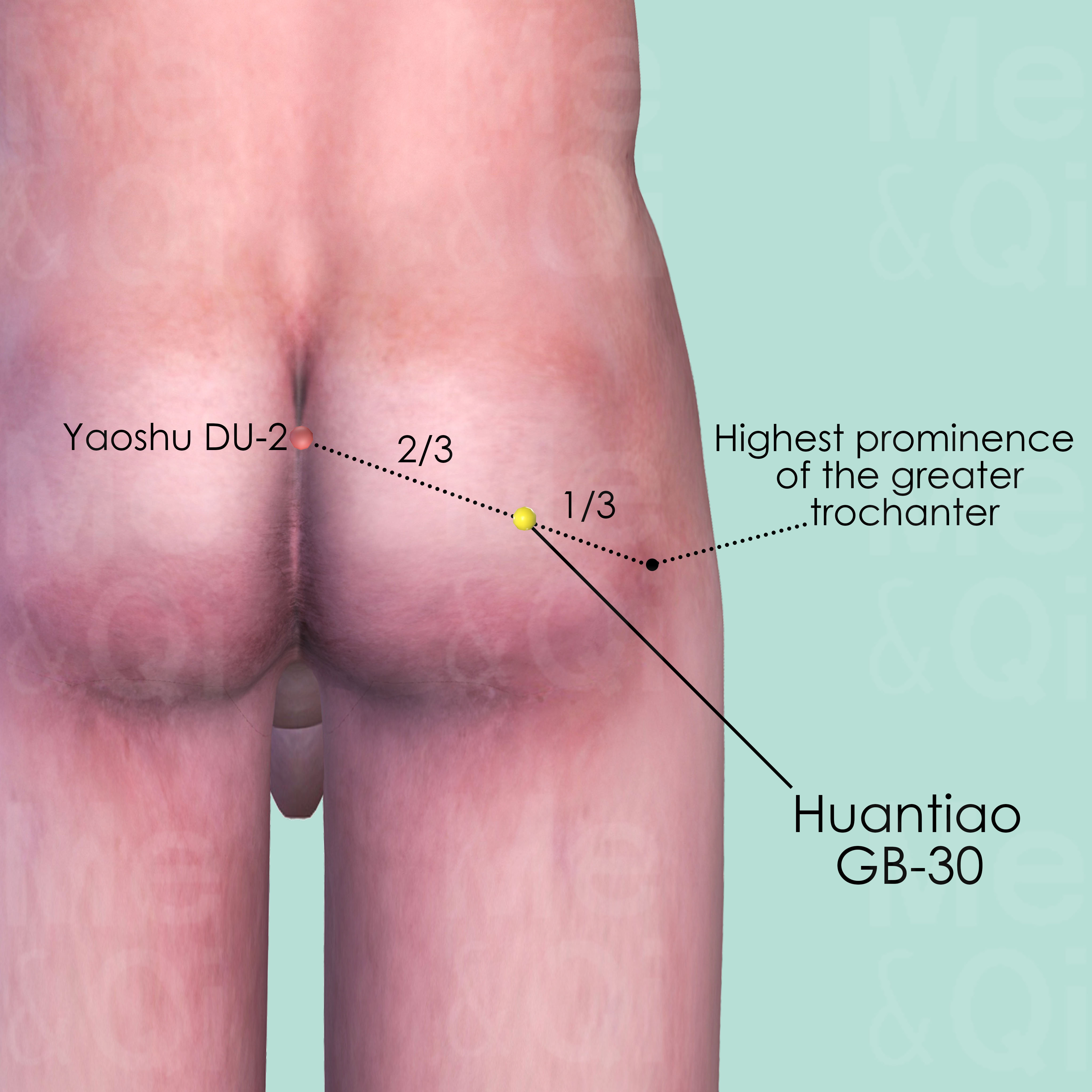
Huantiao GB-30
At the junction of the middle and lateral third of the distance between the great trochanter and Yaoshu DU-2 of the hiatus of the sacrum. When locating the point, put the patient in lateral recumbent position with the thigh flexed.
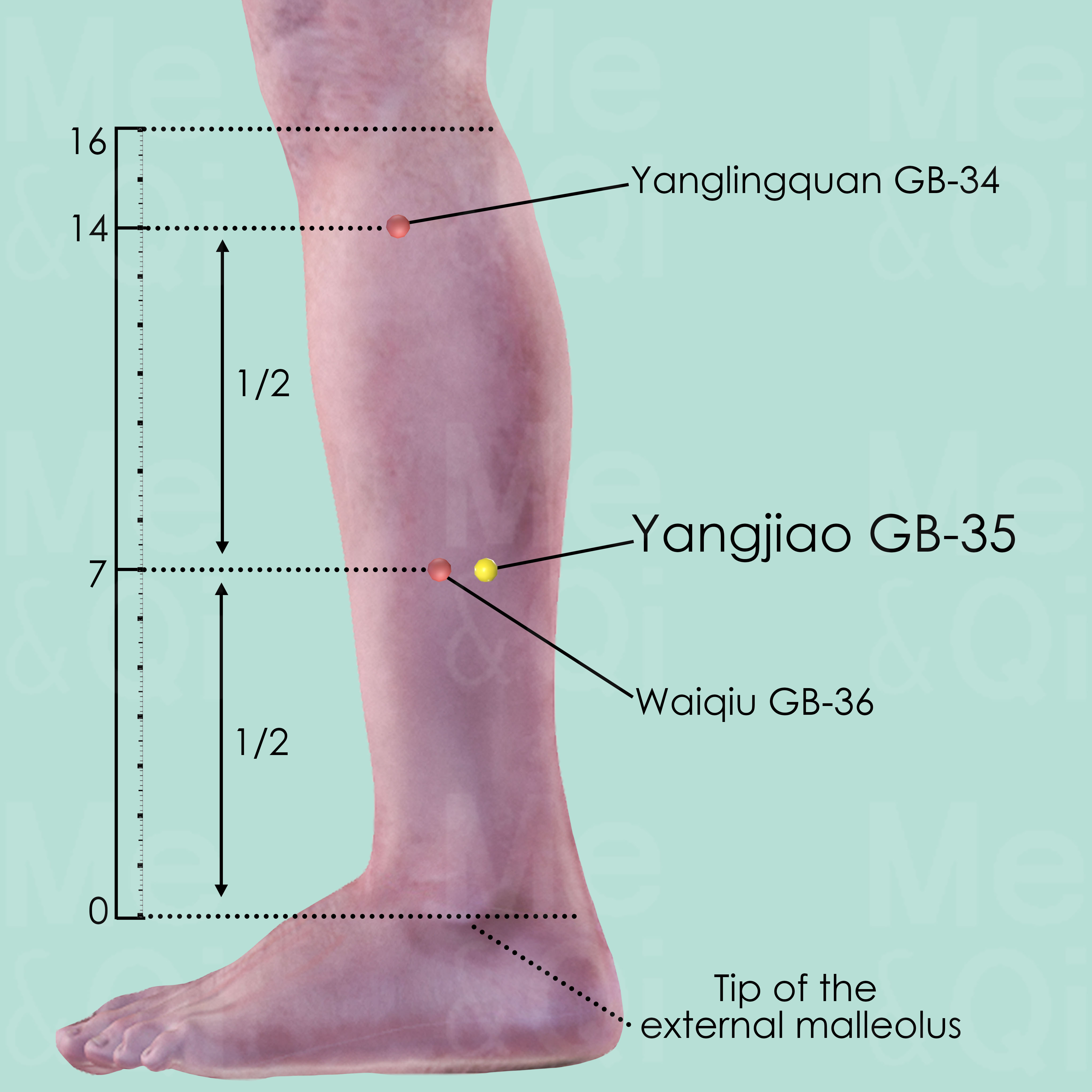
Yangjiao GB-35
7 cun above the tip of the external malleolus, on the posterior border of the fibula, within the distance between the tip of the external malleolus and Yanglingquan GB-34. It is also at the same level as Waiqiu GB-36.
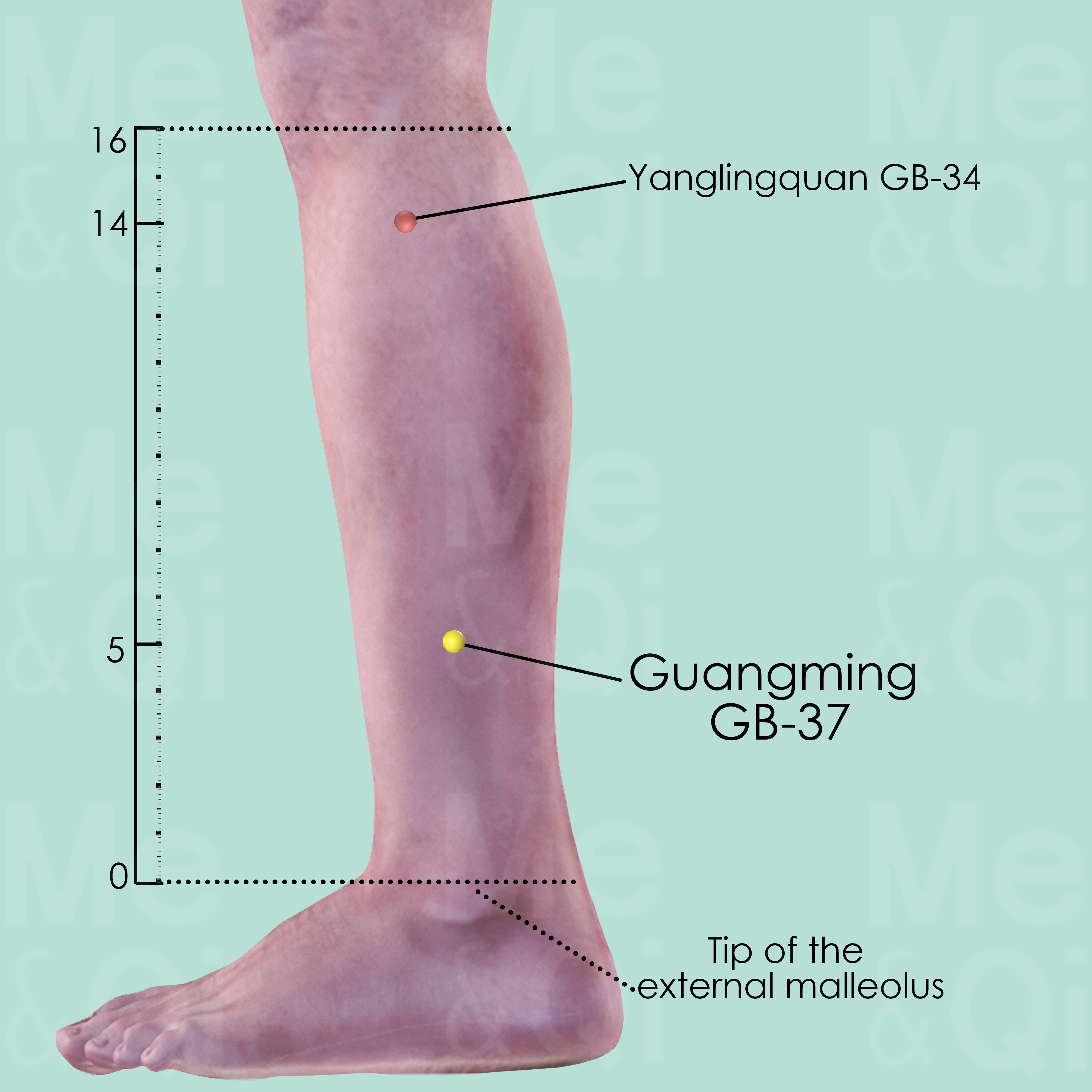
Guangming GB-37
5 cun directly above the tip of the external malleolus, on the anterior border of the fibula.
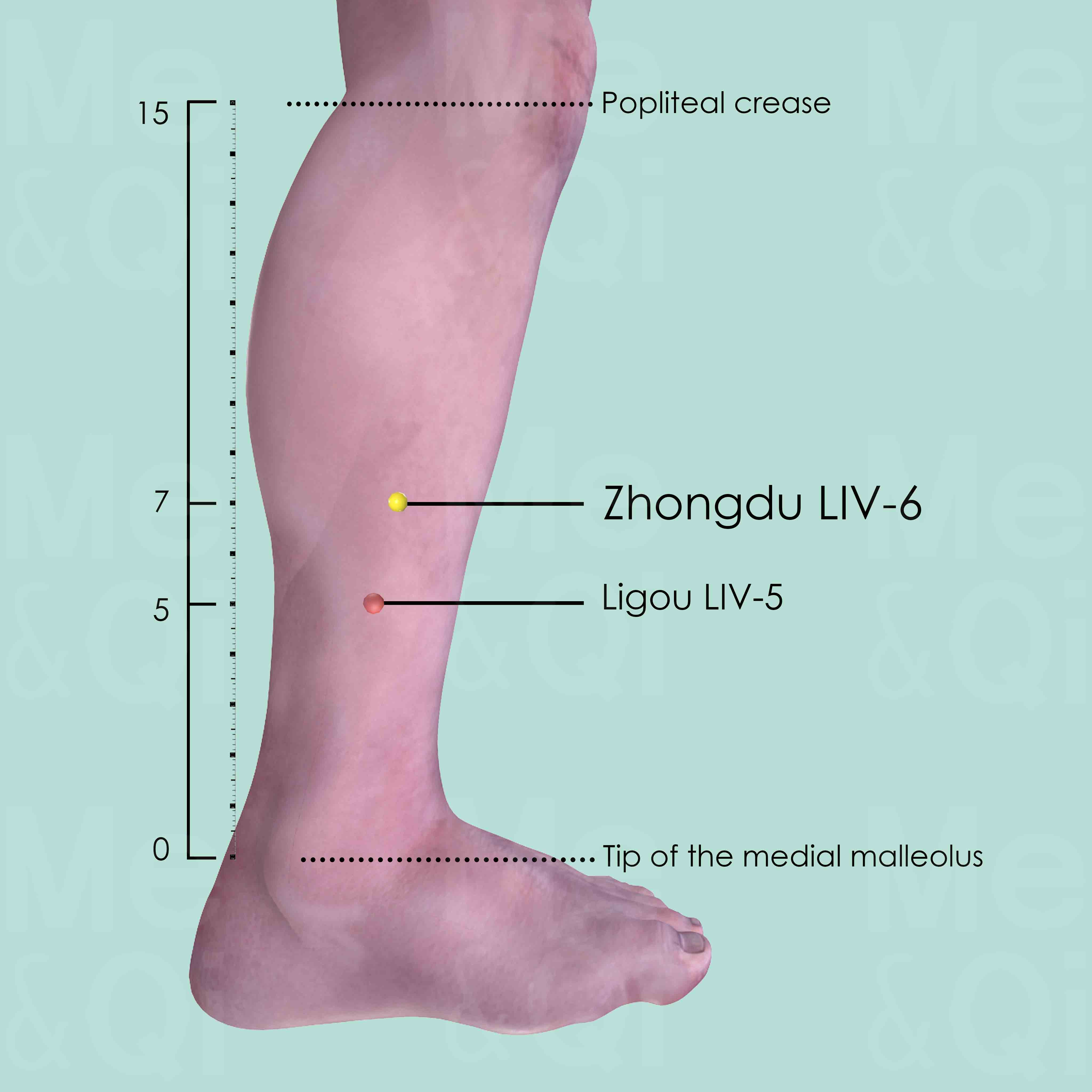
Zhongdu LIV-6
7 cun above the tip of the medial malleolus, or 2 cun above Ligou LIV-5, on the medial aspect and posterior to the medial crest of the tibia.
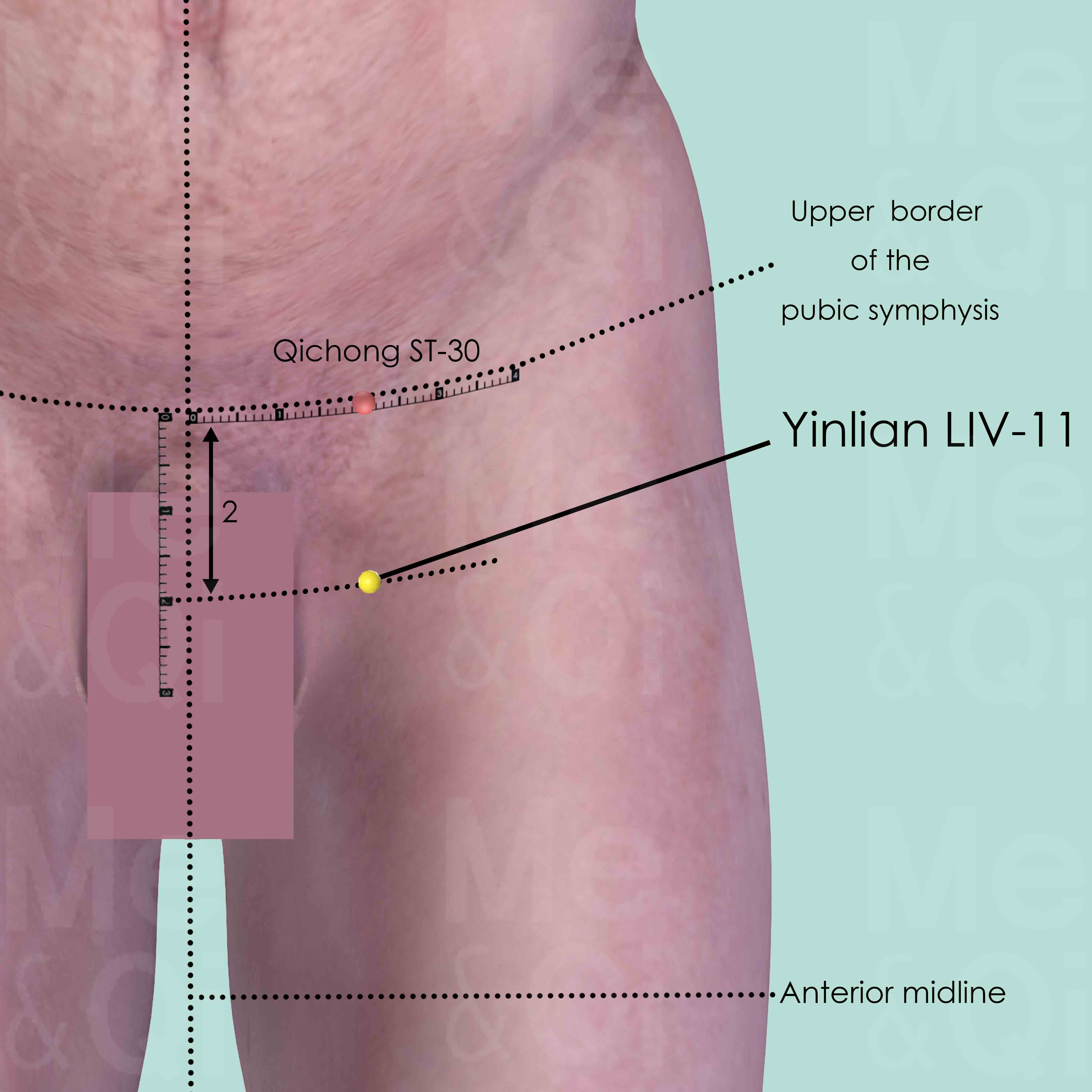
Yinlian LIV-11
2 cun inferior to Qichong ST-30 which is on the upper border of the symphysis and 2 cun lateral to the anterior midline.
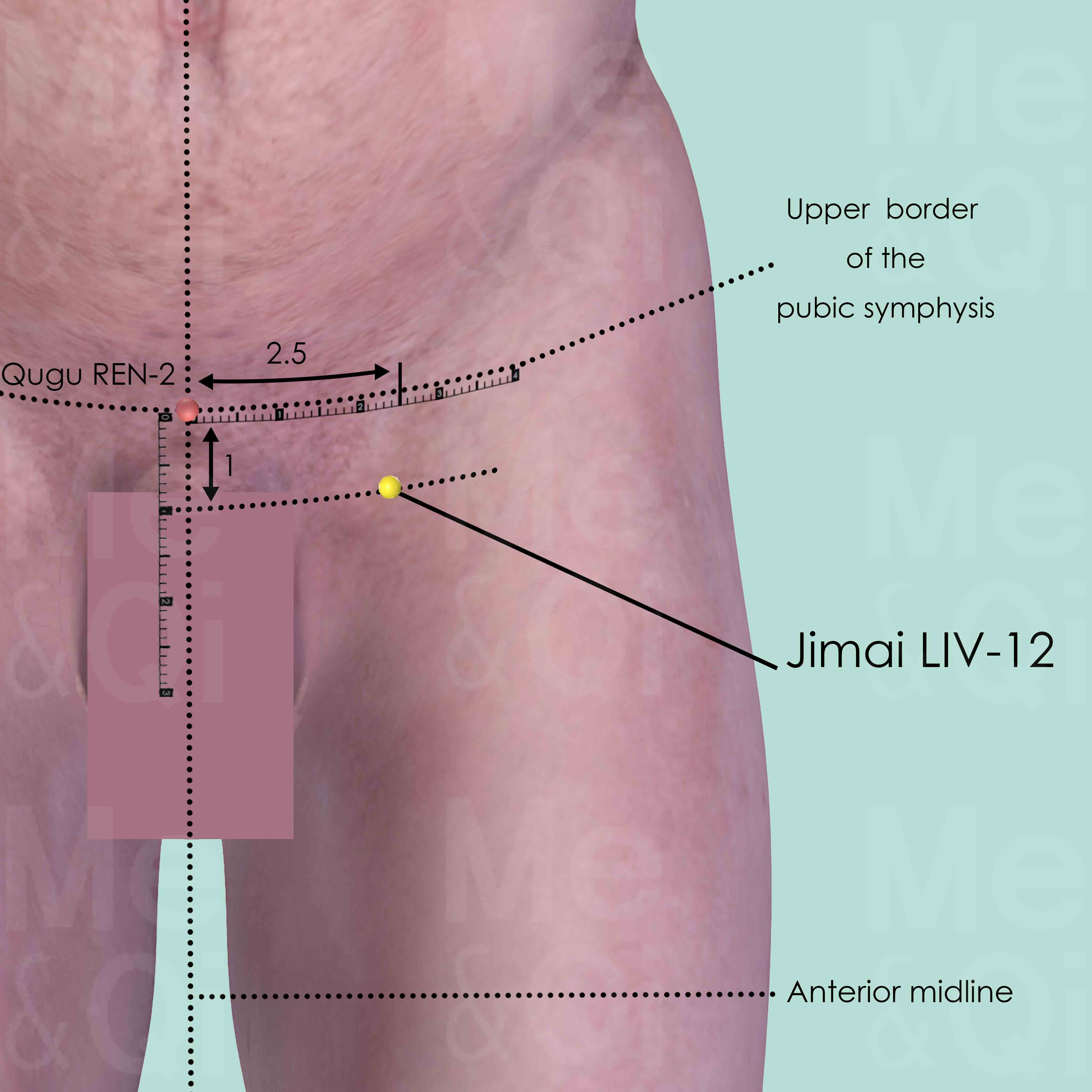
Jimai LIV-12
Interior and lateral to the pubic spine, 2.5 cun lateral to the Qugu REN-2 on the anterior midline and 1 cun inferior to the upper border of the symphysis.
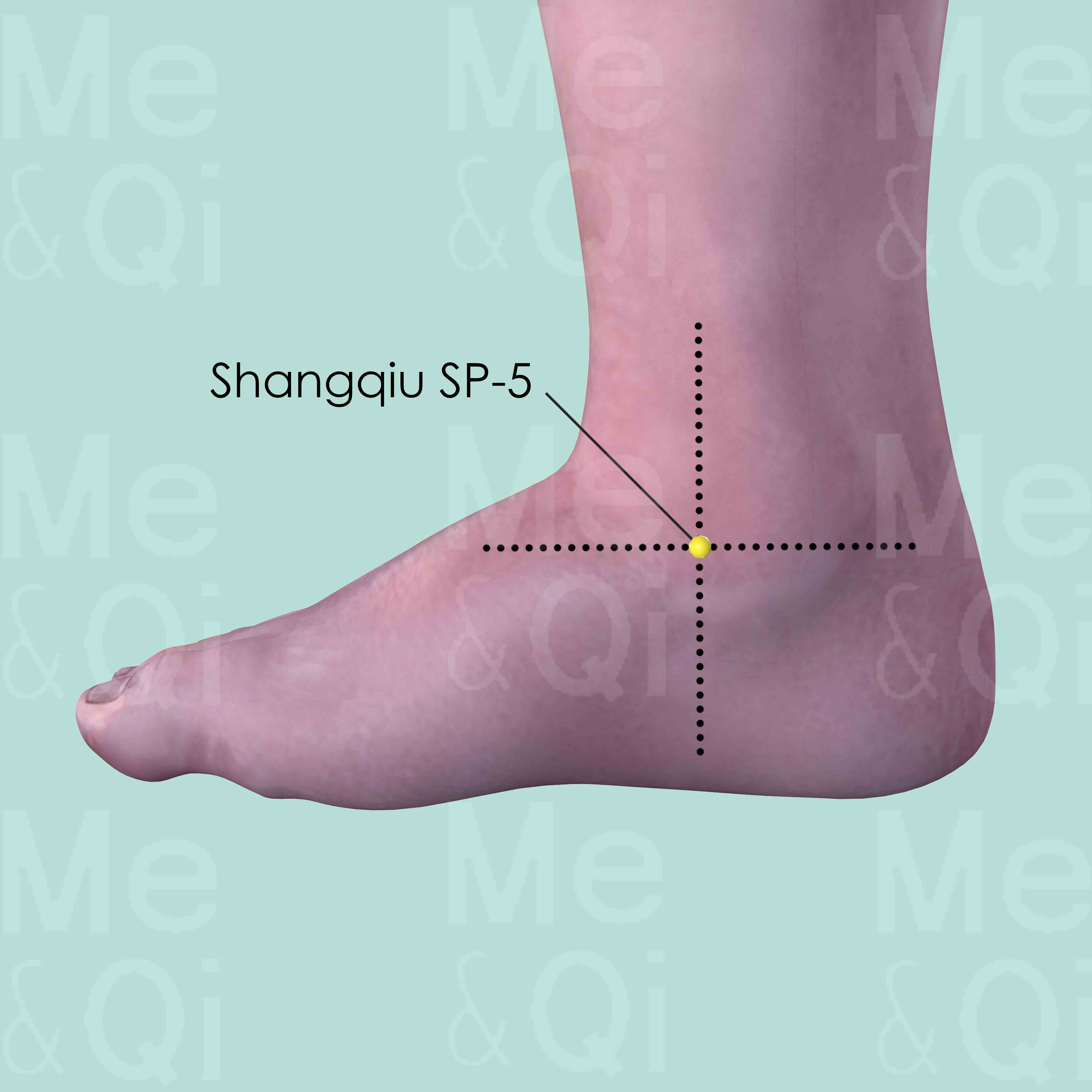
Shangqiu SP-5
In the depression distal and inferior to the medial malleolus, midway between the navicular bone tubercle and the tip of the medial malleolus.
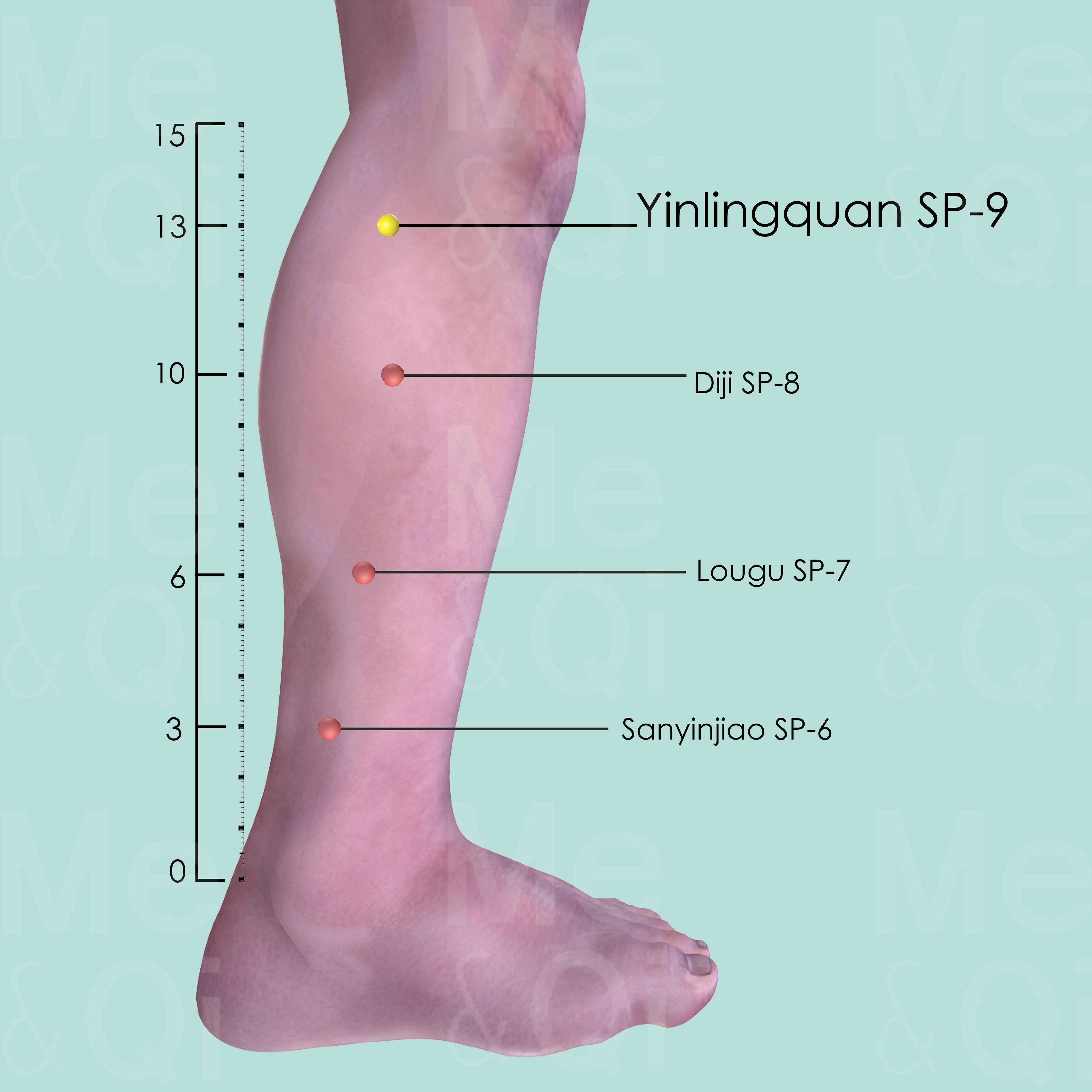
Yinlingquan SP-9
On the lower border of the medial condyle of the tibia, in the depression between the posterior border of the tibia and gastrocnemius muscle.

